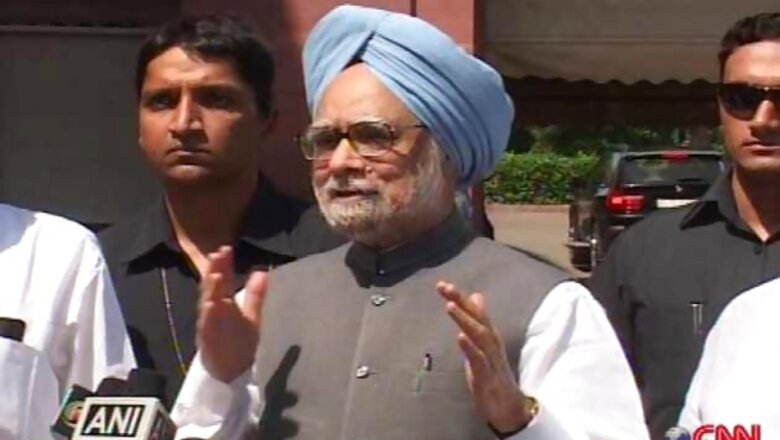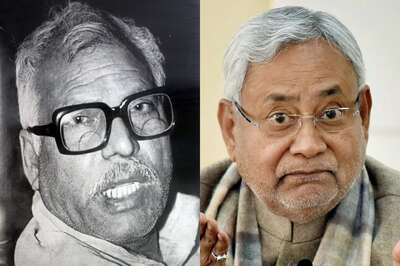
views
New Delhi: The Prime Minister's Office on Wednesday issued a clarification on the coal block allocation, claiming that the step was essential for high growth. The PMO issued a seven-point clarification by the Coal Ministry on the allocation.
In the statement, the Ministry has pointed that though the allocation to private companies for captive use commenced in 1993, the demand grew with the growing economy, which further pressed for the need of a bigger role of the private sector.
"We should appreciate the reasons for allocation of coal blocks to private parties for captive use during the period," says the release.
It further says, "While allocation of coal blocks began in 1993, it was only in 2004 that for the first time, the idea of making allocations through competitive bidding was mooted and in 2005 the government initiated a proposal to amend the Coal Mines (Nationalization) Act."
The statement has further said that the following delay of three years was because of consensus building.
Here is the full text of the reply by the Coal Ministry:
Doubts have been raised in certain quarters regarding allocation of coal blocks to private companies for captive use during the period 2004-2009. As per media reports letters have also been written purportedly to the Government raising similar issues. Clarifications in regard to these issues had already been placed on the website of the Ministry of Coal on 17th May, 2012. However, certain issues are reiterated and further clarified as below:
1. Allocation of coal blocks to private companies for captive use commenced in the year 1993 after the Coal Mines (Nationalisation) Act, 1973 was amended. This was done with the objective of attracting private investments in specified end uses. Initially there was not much demand for such allocation and the applicants themselves used to identify the coal blocks and seek allocation. As the economy grew in size, the demand for coal also grew, particularly due to expansion in the energy sector. It was felt that Coal India Ltd. alone would not be able to meet the growing demand and, therefore, the option of giving a bigger role to the private sector was explored. It is in this background that we should appreciate the reasons for allocation of coal blocks to private parties for captive use during this period.
2. While allocation of coal blocks began in 1993, it was only in 2004 that for the first time, the idea of making allocations through competitive bidding was mooted and in 2005 the government initiated a proposal to amend the Coal Mines (Nationalization) Act. The delay of three years between initiating the process of legislative changes and introducing the amendment Bill in the Parliament was mainly due to time taken in consensus building among divergent views of the various stakeholders. State governments such as Chhattisgarh, West Bengal and Rajasthan were opposed to the amendment as they felt that it would increase the cost of coal, adversely impact value addition and development of industries in their areas and would dilute their prerogative in selection of an allocatee. Ministry of Power, too, felt that auctioning of coal may lead to enhanced cost of coal. Legal issues of whether amendment was required in the Coal Mines (Nationalization) Act or Mines& Minerals (Development & Regulation) Act (MMDR Act) were to be carefully examined. It was only through multilayered consultations and discussions that these issues were finally resolved and the amendment Bill could be introduced in the Rajya Sahba in 2008. The central government was always keen to quickly push through the changes. However, it could not have moved ahead without duly considering the concerns of various stakeholders.
3. In the meanwhile, keeping in view the increase in applicants for coal blocks, the government evolved a consolidated set of guidelines to ensure consistency in allocation. In September 2005 the system was further improved bringing in greater transparency. In the improved system applications were invited through open advertisements against an identified list of coal blocks.
4. Even as the process of switching over from Screening Committee procedure to competitive bidding was initiated, it was felt that the required legislative changes would be time consuming. On the other hand, imperatives of economic growth required massive capacity addition and this issue was deliberated at length in the meetings of the Energy Coordination Committee that had recommended allocation of coal blocks to prospective power producers. It would not have been prudent to disrupt the momentum of accelerated investments in coal sector, especially as it was felt that it would take time in bringing about the required legislative and the consequent procedural changes. If the coal blocks were not made available between 2005 and 2010, it would have resulted in higher imports causing outflow of foreign exchange and would have had deleterious effect on large investments in crucial sectors like power and steel. These were the main reasons for continuation of allocation of the captive coal blocks. Moreover, it may also be noted that no coal block was offered for allocation after introduction of the Amendment Bill in the Parliament. Whatever allocations have been made after 2008, are as a result of culmination of the process initiated before the introduction of the Bill.
5. It may be stated that the allocation of coal blocks was never looked upon as a potential source for generating revenue for the Central Government. The intent of the government was to induce rapid development of infrastructure which was so very essential to keep the economy on a high growth trajectory. Hence the question of maximizing revenue does not arise at all. The idea of introduction of bidding cropped up only in the wake of increasing demand for captive coal blocks and the consequent necessity of putting in place a process which is demonstrably more transparent.
6. The intent of the government was to involve the private sector to invest in identified infrastructure sectors in the interest of the country and its economy and, to this end; this developmental process was resorted to. The allocation of coal blocks to private sector companies is only for captive use and not for sale or commercial use of coal. Since the blocks are allocated to private companies only for captive purposes for the specified end-use the question of linking the blocks to the market price/CIL price of coal does not arise at all.
7. It may be pointed out that the coal blocks for captive end use were allotted on the basis of recommendations of a Screening Committee which followed a fair and transparent procedure giving equal opportunity to all applicants. The Screening Committee was a broad based body with representation from State Governments at the level of the Chief Secretaries, concerned Ministries of the Central Government and the coal companies. The procedure adopted for allocation involved wide consultations with all stakeholders. The parameters and the guidelines for allocation were duly notified and followed by the committee while evaluating the applications. Comprehensive details about the applicant/the group, performance of the group, financial strength, readiness of the end-use plant, etc. were placed before the committee enabling it to assess the comparative merits of the applicants and make fair and just recommendations. Details of each application were shared with the concerned state government and the line ministry. The applicant was also provided an opportunity to present his case before the screening committee. The Screening Committee assessed the applications having regard to the matters such as techno-economic feasibility of the end use project, status of preparedness to set up the end use project, past track record in execution of projects, financial and technical capabilities of the applicant companies, recommendations of the state governments and the Administrative Ministry concerned. The process of allocation of blocks was equitable, fair and just which is borne out of the fact that there has never been any serious allegation against the working of the screening committee. The move to introduce competitive bidding is to make the selection process demonstrably more transparent.




















Comments
0 comment